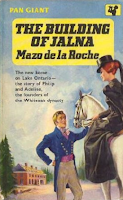
The Whiteoak books represent the idealized portrait of Canada, which all English people have. Life is hardly ever painful at Jalna. It's comfortable, it's exciting, there are domestic dramas going on. I think that Englishmen like to believe that anywhere abroad life goes on as it used to go on in England. We always like to think that life for our parents must have been wonderful and life for us is horrid. Englishmen reading about the Whiteoaks think that life is lived that way now, and we know that life is not lived that way in England – or in Canada.
– Lovat Dickson
In the final pages of his 1966 biography, Mazo de la Roche of Jalna, Ronald Hambleton remarks on the very different reception the author has been accorded by her "three most important audiences". American acclaim, brought when Jalna took the 1927 Atlantic Monthly Award for "novel of the year", faded as the series progressed. Canadians cooled as that it became apparent that de la Roche's focus was on a country that had long passed. Hambleton concludes, "in Britain her reception continued and continues to be warm."
 By the mid-sixties, Pan, de la Roche's British paperback publisher since 1948, had sold more than two million copies of the series' titles. Things were still balmy on 20 May 1971, when The Whiteoaks of Jalna began filming. In The Secret of Jalna, the enthusiastic Ronald Hambleton writes of "the careening Jalnawagon, whose pace as a literary phenomenon has showed no signs of slackening since Mazo de la Roche pencilled the first lines in late 1925."
By the mid-sixties, Pan, de la Roche's British paperback publisher since 1948, had sold more than two million copies of the series' titles. Things were still balmy on 20 May 1971, when The Whiteoaks of Jalna began filming. In The Secret of Jalna, the enthusiastic Ronald Hambleton writes of "the careening Jalnawagon, whose pace as a literary phenomenon has showed no signs of slackening since Mazo de la Roche pencilled the first lines in late 1925."
In 1972, Pan issued tie-in editions that featured stills from the series and did one more revamp. Now, the Jalnawagon runs no more... at least not for Pan. Toronto's Dundurn Press publishes the sixteen books of the Whiteoak Chronicles with a cover image of "Benares", the Mississauga home upon with Jalna was modelled. They're attractive enough, but I much prefer the Pan editions of the 'fifties and 'sixties. A visual feast:
















Jalna panned:

The Globe & Mail, 7 January 1972
Related posts:





































